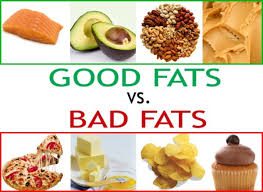Fats are an essential part of our diet, playing a critical role in energy production, brain function, and nutrient absorption. However, not all fats are created equal. Understanding the difference between good fats and bad fats can significantly impact your health and well-being. In this guide, we’ll explore what makes fats “good” or “bad,” their effects on your body, and how to make smarter dietary choices.
What Are Fats and Why Are They Important?
Fats, or lipids, are one of the three macronutrients (along with carbohydrates and proteins) that provide energy for the body. They are essential for:
- Energy Storage: Fats are a concentrated source of energy.
- Cell Function: They form the structural components of cell membranes.
- Nutrient Absorption: Fats help absorb fat-soluble vitamins like A, D, E, and K.
- Hormone Production: Many hormones, including those related to reproduction and metabolism, rely on fats.
Despite their importance, not all fats benefit our health equally.
The Difference Between Good Fats and Bad Fats
Good Fats: Healthy and Essential
Good fats, also known as unsaturated fats, help promote heart health, brain function, and overall wellness. They are primarily found in plant-based oils, nuts, seeds, fish, and certain fruits.
Types of Good Fats
- Monounsaturated Fats (MUFAs):
- Found in olive oil, avocados, nuts, and seeds.
- Benefits: Reduces bad cholesterol (LDL) levels, supports brain health, and lowers inflammation.
- Polyunsaturated Fats (PUFAs):
- Found in fatty fish, walnuts, flaxseeds, and sunflower oil.
- Omega-3 and Omega-6 fatty acids are essential types of PUFAs.
- Benefits: Improves heart health, reduces risk of stroke, and supports brain function.
- Omega-3 Fatty Acids:
- Found in salmon, mackerel, chia seeds, and algae.
- Benefits: Reduces inflammation, lowers triglycerides, and supports mental health.

Why Good Fats Matter
Good fats can:
- Improve cholesterol levels.
- Reduce the risk of heart disease and stroke.
- Support brain health and cognitive function.
- Aid in maintaining a healthy weight by promoting satiety.
Bad Fats: Harmful to Health
Bad fats are typically found in processed and fried foods. These fats can raise cholesterol levels, increase the risk of heart disease, and contribute to other health problems.
Types of Bad Fats
- Saturated Fats:
- Found in red meat, butter, cheese, and coconut oil.
- Risks: Raises LDL cholesterol levels, increasing the risk of heart disease when consumed in excess.
- Trans Fats:
- Found in hydrogenated oils, margarine, baked goods, and fried foods.
- Risks: Raises LDL cholesterol, lowers HDL cholesterol, and significantly increases the risk of heart disease, stroke, and diabetes.
Why Bad Fats Are Harmful
Bad fats can:
- Increase the risk of heart disease.
- Promote inflammation.
- Contribute to weight gain and obesity-related health problems.
How to Identify Good and Bad Fats in Your Diet
Reading Food Labels
- Look for terms like “partially hydrogenated oils” to identify trans fats.
- Choose products labeled as low in saturated fats and free from trans fats.
Focus on Whole Foods
- Prioritize whole, unprocessed foods like avocados, nuts, seeds, and fatty fish.
- Minimize consumption of processed snacks, baked goods, and fried items.
Healthy Cooking Methods
- Use olive or avocado oil for cooking instead of butter or margarine.
- Opt for grilling, baking, or steaming over frying.
Practical Tips for Choosing Good Fats
- Include Fatty Fish in Your Diet: Aim for at least two servings of fatty fish, like salmon or mackerel, per week.
- Snack Smart: Replace chips with nuts or seeds for a healthier alternative.
- Cook with Heart-Healthy Oils: Use olive oil or avocado oil instead of lard or vegetable shortening.
- Add Avocado: Use avocado as a spread or in salads for a dose of monounsaturated fats.
- Avoid Trans Fats: Eliminate processed foods containing hydrogenated oils.
Common Myths About Fats
Myth 1: All Fats Make You Gain Weight
Not all fats are equal. Good fats can actually help regulate appetite and support weight management.
Myth 2: Low-Fat Diets Are Healthier
Eliminating fats entirely can deprive your body of essential nutrients. Focus on the quality of fats rather than the quantity.
Myth 3: Coconut Oil Is a Healthy Fat
While coconut oil contains saturated fats, its effects on health are still debated. Use it sparingly.
Conclusion
Understanding the difference between good fats and bad fats is essential for maintaining optimal health. Incorporate healthy fats from sources like avocados, nuts, seeds, and fatty fish, while minimizing bad fats found in processed and fried foods. By making informed dietary choices, you can protect your heart, improve brain function, and enjoy a healthier lifestyle.
FAQ
1. What are examples of good fats?
Good fats include monounsaturated fats (found in olive oil and avocados) and polyunsaturated fats (found in fatty fish, flaxseeds, and walnuts).
2. Why are trans fats bad for you?
Trans fats raise bad cholesterol (LDL) and lower good cholesterol (HDL), increasing the risk of heart disease and stroke.
3. Can eating fats help with weight loss?
Yes, healthy fats can promote satiety, helping you feel fuller for longer and reducing overeating.
4. How much fat should I eat daily?
The American Heart Association recommends that fats make up 20-35% of your daily calories, with a focus on unsaturated fats.
5. Is butter a good fat or bad fat?
Butter contains saturated fats and should be consumed in moderation as part of a balanced diet.
Discover the difference between good and bad fats, why it matters for your health, and how to choose the right fats for a balanced diet. Improve your well-being today!